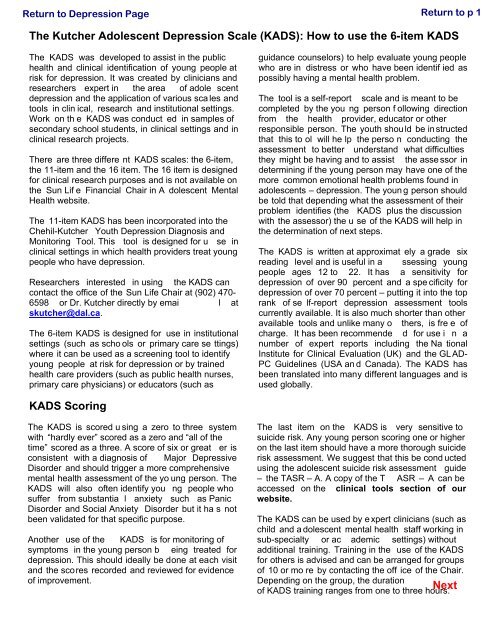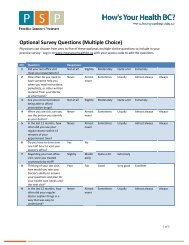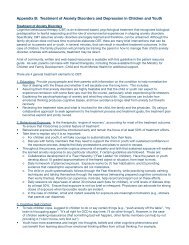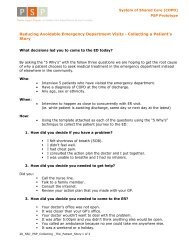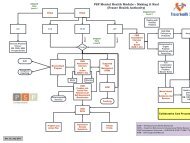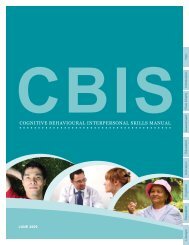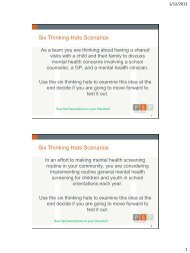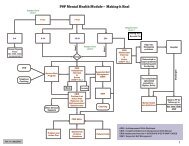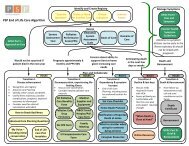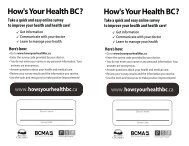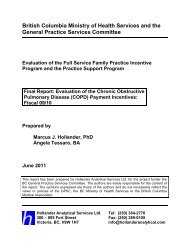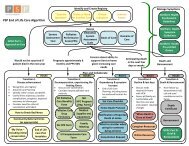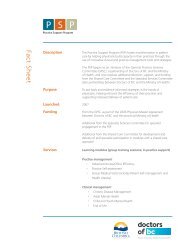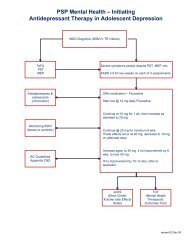Child & Youth Mental Health Algorithm - GPSC
Child & Youth Mental Health Algorithm - GPSC
Child & Youth Mental Health Algorithm - GPSC
Create successful ePaper yourself
Turn your PDF publications into a flip-book with our unique Google optimized e-Paper software.
The Kutcher Adolescent Depression Scale (KADS): How to use the 6-item KADSThe KADS was developed to assist in the publichealth and clinical identification of young people atrisk for depression. It was created by clinicians andresearchers expert in the area of adole scentdepression and the application of various sca les andtools in clin ical, research and institutional settings.Work on th e KADS was conduct ed in samples ofsecondary school students, in clinical settings and inclinical research projects.There are three differe nt KADS scales: the 6-item,the 11-item and the 16 item. The 16 item is designedfor clinical research purposes and is not available onthe Sun Lif e Financial Chair in A dolescent <strong>Mental</strong><strong>Health</strong> website.The 11-item KADS has been incorporated into theChehil-Kutcher <strong>Youth</strong> Depression Diagnosis andMonitoring Tool. This tool is designed for u se inclinical settings in which health providers treat youngpeople who have depression.Researchers interested in using the KADS cancontact the office of the Sun Life Chair at (902) 470-6598 or Dr. Kutcher directly by emai l atskutcher@dal.ca.The 6-item KADS is designed for use in institutionalsettings (such as scho ols or primary care se ttings)where it can be used as a screening tool to identifyyoung people at risk for depression or by trainedhealth care providers (such as public health nurses,primary care physicians) or educators (such asguidance counselors) to help evaluate young peoplewho are in distress or who have been identif ied aspossibly having a mental health problem.The tool is a self-report scale and is meant to becompleted by the you ng person f ollowing directionfrom the health provider, educator or otherresponsible person. The youth shou ld be in structedthat this to ol will he lp the perso n conducting theassessment to better understand what difficultiesthey might be having and to assist the asse ssor indetermining if the young person may have one of themore common emotional health problems found inadolescents – depression. The youn g person shouldbe told that depending what the assessment of theirproblem identifies (the KADS plus the discussionwith the assessor) the u se of the KADS will help inthe determination of next steps.The KADS is written at approximat ely a grade sixreading level and is useful in a ssessing youngpeople ages 12 to 22. It has a sensitivity fordepression of over 90 percent and a spe cificity fordepression of over 70 percent – putting it into the toprank of se lf-report depression assessment toolscurrently available. It is also much shorter than otheravailable tools and unlike many o thers, is fre e ofcharge. It has been recommende d for use i n anumber of expert reports including the Na tionalInstitute for Clinical Evaluation (UK) and the GLAD-PC Guidelines (USA an d Canada). The KADS hasbeen translated into many different languages and isused globally.KADS ScoringThe KADS is scored u sing a zero to three systemwith “hardly ever” scored as a zero and “all of thetime” scored as a three. A score of six or great er isconsistent with a diagnosis of Major DepressiveDisorder and should trigger a more comprehensivemental health assessment of the yo ung person. TheKADS will also often identify you ng people whosuffer from substantia l anxiety such as PanicDisorder and Social Anxiety Disorder but it ha s notbeen validated for that specific purpose.Another use of the KADS is for monitoring ofsymptoms in the young person b eing treated fordepression. This should ideally be done at each visitand the scores recorded and reviewed for evidenceof improvement.The last item on the KADS is very sensitive tosuicide risk. Any young person scoring one or higheron the last item should have a more thorough suiciderisk assessment. We suggest that this be cond uctedusing the adolescent suicide risk assessment guide– the TASR – A. A copy of the T ASR – A can beaccessed on the clinical tools section of ourwebsite.The KADS can be used by e xpert clinicians (such aschild and a dolescent mental health staff working insub-specialty or ac ademic settings) withoutadditional training. Training in the use of the KADSfor others is advised and can be arranged for groupsof 10 or mo re by contacting the off ice of the Chair.Depending on the group, the durationof KADS training ranges from one to three hours.


